
Blog Post
How to Predict Your Progress On Guitar, Stay Super Motivated And Create A Fool-Proof Practice Plan
- by Tom Boddison
- •
- 16 Sept, 2017

Progress on guitar tends to come in two forms:
1) Gradual progress, with skills that you improve gradually over time. This is the bit-by-bit progress you get each day in things like scales, chords etc.
2) Bursts of progress, with skills that tend to stagnate for a while before suddenly becoming much better. This is often what happens with skills like picking technique, and other technical challenges (such as my experience with flamenco rasgueado strumming).
As discussed in the last article (don't worry, you don't have to read it to understand this article), our brain automatically makes assumptions about how much progress we will make.
This can be a good thing, because it gives us an idea of how long we might take to learn something.
However, most of the time these subconscious expectations are way off, leading to frustration and a feeling of helplessness ("Why can't I learn this?!").
If we could accurately predict exactly what progress we'll make and when - including getting a rough idea of what our motivation will be like at any given point - then we'd be able to smash through almost any challenge without too much trouble.
We'd be able to prepare for plateaus before we hit them, and we'd always know if we were on track to our goals - pretty awesome, right?
In this lesson we're gonna go through some key strategies you can use to predict the results you'll get - and how to use this info to become a better player.
1) Gradual progress, with skills that you improve gradually over time. This is the bit-by-bit progress you get each day in things like scales, chords etc.
2) Bursts of progress, with skills that tend to stagnate for a while before suddenly becoming much better. This is often what happens with skills like picking technique, and other technical challenges (such as my experience with flamenco rasgueado strumming).
As discussed in the last article (don't worry, you don't have to read it to understand this article), our brain automatically makes assumptions about how much progress we will make.
This can be a good thing, because it gives us an idea of how long we might take to learn something.
However, most of the time these subconscious expectations are way off, leading to frustration and a feeling of helplessness ("Why can't I learn this?!").
If we could accurately predict exactly what progress we'll make and when - including getting a rough idea of what our motivation will be like at any given point - then we'd be able to smash through almost any challenge without too much trouble.
We'd be able to prepare for plateaus before we hit them, and we'd always know if we were on track to our goals - pretty awesome, right?
In this lesson we're gonna go through some key strategies you can use to predict the results you'll get - and how to use this info to become a better player.
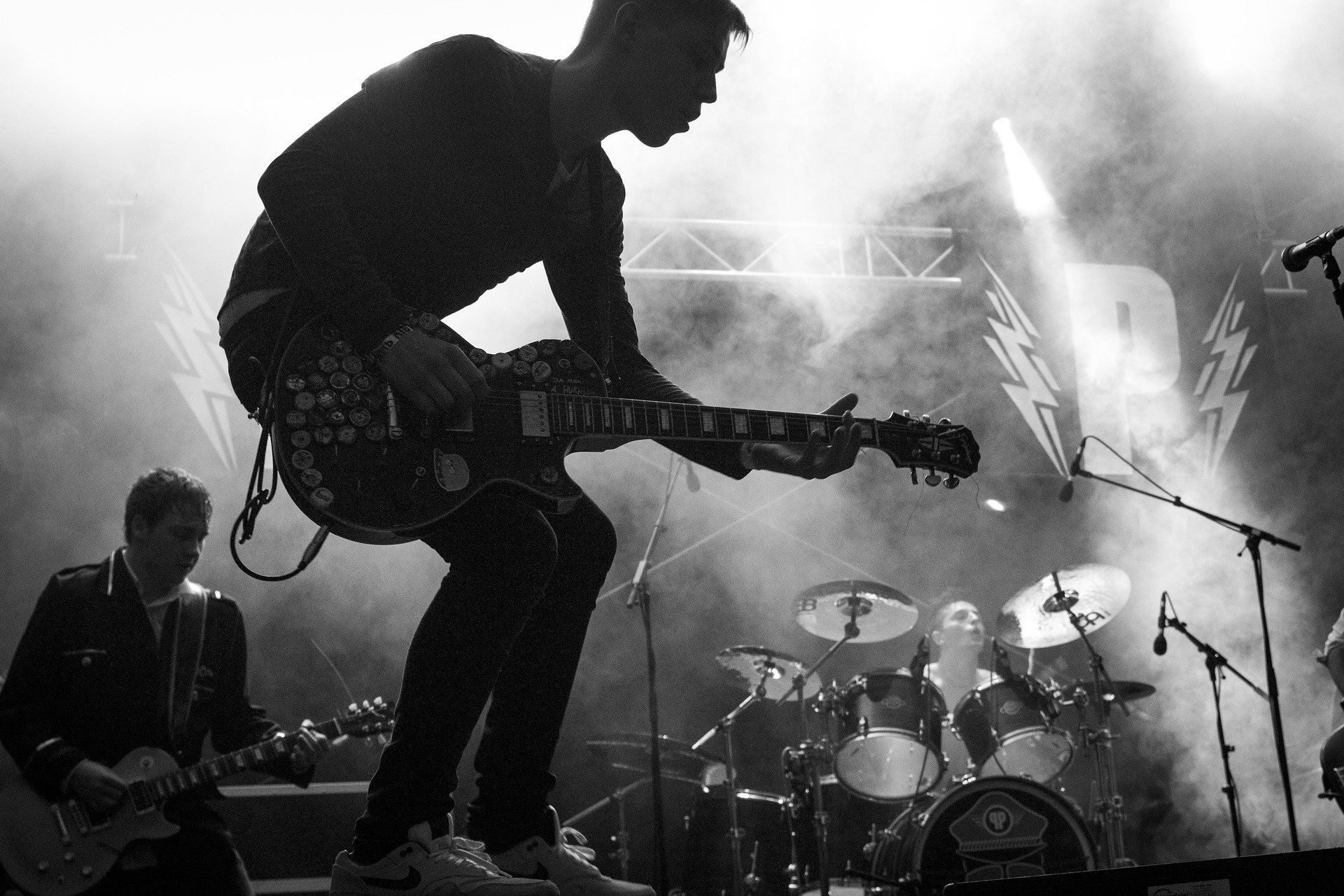
The Biggest Problem
There's a problem with trying to predict your progress on guitar, though.
It's difficult to predict how good you'll be after X hours of practice, because...
...we don't control how quickly we learn.
Or, more accurately, we don't completely control how quickly we learn.
If you take two people at the same level, with the same experiences, and give them the same material to work on, for the same number of hours, and give them both effective practice methods that suit them, they'll progress at pretty much the same rate.
The problem is, there are still variables. Just because we can increase or decrease our learning speed using specific strategies, it doesn't mean that we can precisely predict our results.
Everyone has slightly different experiences. Everyone is at different levels in different skills. Nobody really knows exactly how quickly you'll learn something.
It's difficult to predict how good you'll be after X hours of practice, because...
...we don't control how quickly we learn.
Or, more accurately, we don't completely control how quickly we learn.
If you take two people at the same level, with the same experiences, and give them the same material to work on, for the same number of hours, and give them both effective practice methods that suit them, they'll progress at pretty much the same rate.
The problem is, there are still variables. Just because we can increase or decrease our learning speed using specific strategies, it doesn't mean that we can precisely predict our results.
Everyone has slightly different experiences. Everyone is at different levels in different skills. Nobody really knows exactly how quickly you'll learn something.

However...
The Solution
...that doesn't mean that we can't have a good guess.
I'm gonna show you a graph that I recently found in a book on accelerated learning. I've found it really useful for predicting how the learning process will go.
It's not great for predicting how quickly you'll learn something (more on that later), but it's awesome for tracking your learning process and dealing with plateaus.
Here it is:
I'm gonna show you a graph that I recently found in a book on accelerated learning. I've found it really useful for predicting how the learning process will go.
It's not great for predicting how quickly you'll learn something (more on that later), but it's awesome for tracking your learning process and dealing with plateaus.
Here it is:
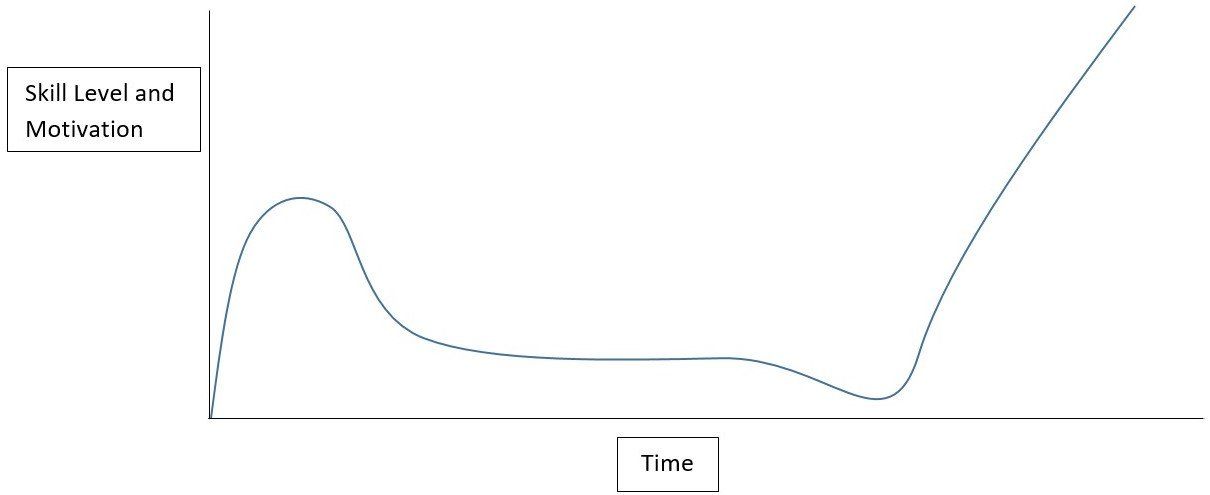
Essentially, this is how your motivation/skills vary with practice.
I was initially sceptical, but after analysing my own learning process I've found this graph surprisingly accurate!
At first you get a little boost of progress, and feel like you're learning well:
I was initially sceptical, but after analysing my own learning process I've found this graph surprisingly accurate!
At first you get a little boost of progress, and feel like you're learning well:
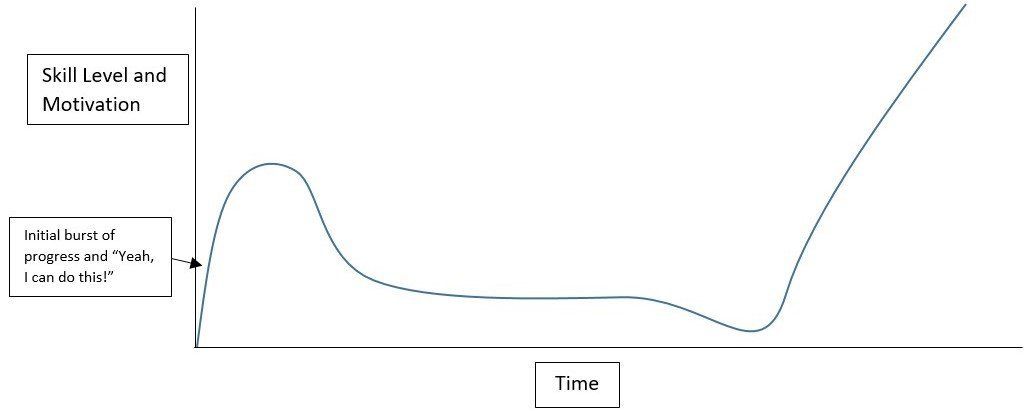
Then you start to move on to more difficult material, and your motivation starts to drop off slightly:
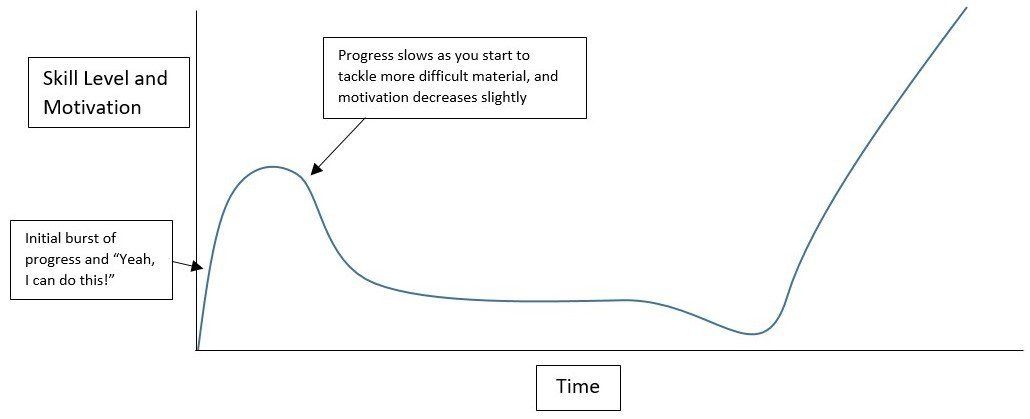
After that you continue working on the more challenging stuff. This is where plateaus of motivation and progress are most likely:
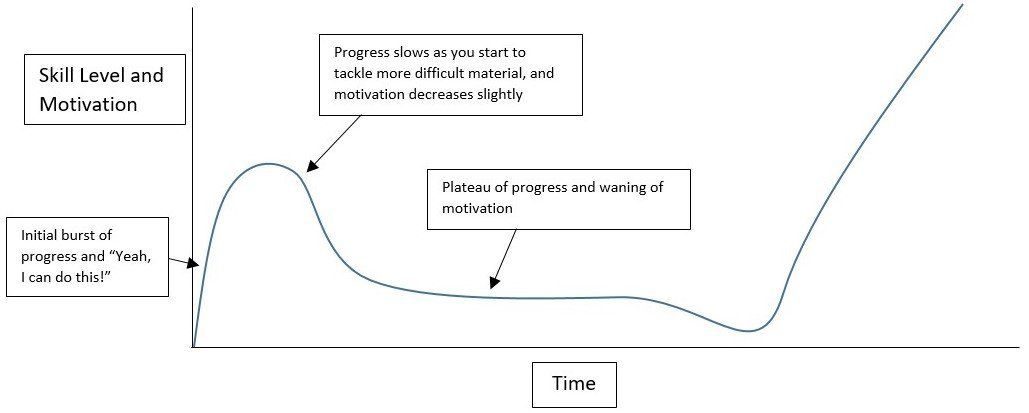
After plateauing for a long time, making only small bits of progress, we tend to hit a "low point", right before...
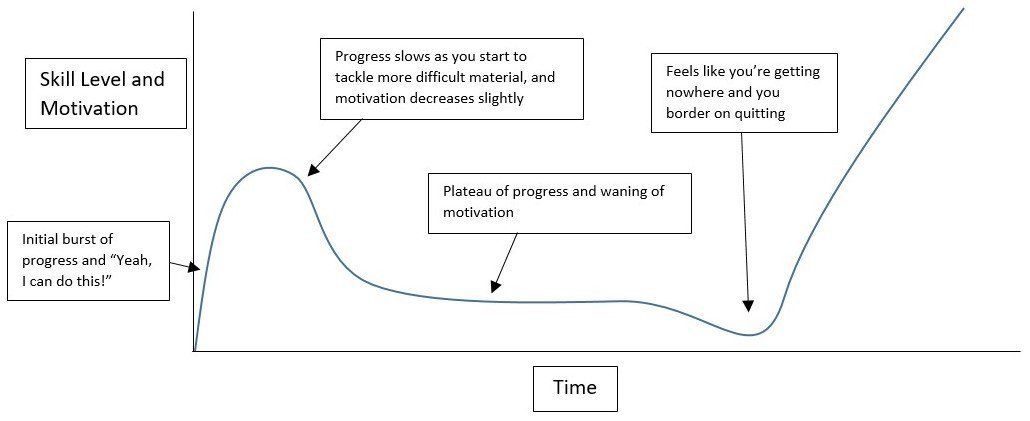
...we get a breakthrough - either by discovering new methods or finally making the practice pay off - and reach our goal.
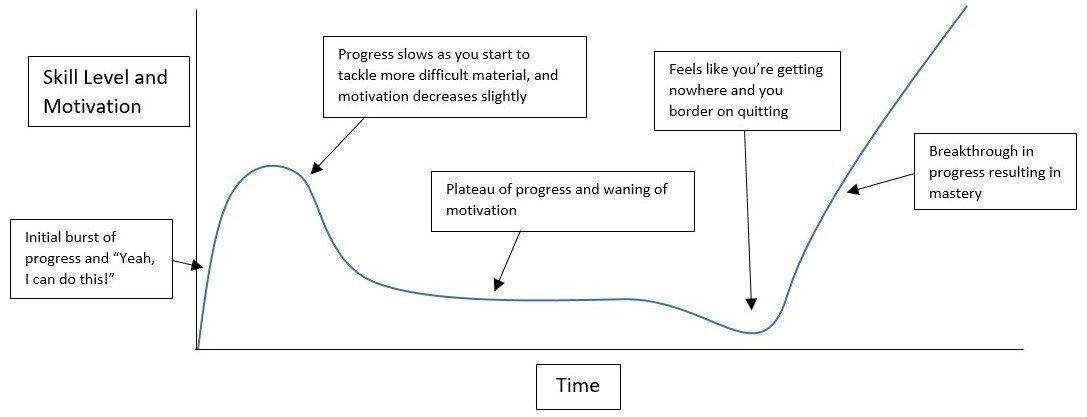
How To Use The Graph
This is all very nice, but how can we USE it?
For a start, the graph is great for motivational purposes.
You can predict roughly when you'll enter a plateau or a low point, and prepare yourself for it. You'll know it's coming so you won't feel helpless or annoyed when you encounter it - it'll be something you expected all along.
You'll also know that if you've entered a plateau in progress, there is a way out and you will conquer it after a time. It's how the learning process works.
Learning is rarely linear; it follows a process of peaks and troughs before you finally achieve your goal. This simple graph helps you to predict the process.
For a start, the graph is great for motivational purposes.
You can predict roughly when you'll enter a plateau or a low point, and prepare yourself for it. You'll know it's coming so you won't feel helpless or annoyed when you encounter it - it'll be something you expected all along.
You'll also know that if you've entered a plateau in progress, there is a way out and you will conquer it after a time. It's how the learning process works.
Learning is rarely linear; it follows a process of peaks and troughs before you finally achieve your goal. This simple graph helps you to predict the process.

Planning Your Practice
You can also use the graph to plan your practice.
Let's say you're spending the next month on ear training, for example.
Look at the graph again:
Let's say you're spending the next month on ear training, for example.
Look at the graph again:

So the first week or so will go pretty well, and you'll make good progress; maybe you'll learn the sounds of your first few intervals.
Then, you'll start to tackle more difficult material (like recognising more complex patterns by ear), and your progress will slow down.
After another two weeks of steady but slow learning, you might feel fed up and like you want to quit. DON'T - you're on the edge of a breakthrough!
Then, in the last week, you'll hit an inflection point and things will start coming together. Finally, the effort will start to pay off, and you'll get to where you wanted.
See how we can predict our progress? It's really useful for motivation.
But wait... this practice plan relies on you actually knowing roughly how long it takes to learn a skill. Otherwise you might still be in a plateau half way through your plan!
Then, you'll start to tackle more difficult material (like recognising more complex patterns by ear), and your progress will slow down.
After another two weeks of steady but slow learning, you might feel fed up and like you want to quit. DON'T - you're on the edge of a breakthrough!
Then, in the last week, you'll hit an inflection point and things will start coming together. Finally, the effort will start to pay off, and you'll get to where you wanted.
See how we can predict our progress? It's really useful for motivation.
But wait... this practice plan relies on you actually knowing roughly how long it takes to learn a skill. Otherwise you might still be in a plateau half way through your plan!
How Quickly Do We Learn?
That's where the next strategy comes in. We're gonna measure your initial progress, and then use that in combination with the graph to find out roughly how quickly you can learn something.
First, choose a skill that you'd like to learn. For this example, we'll use this basic alternate picking lick (I'll show you how to apply it to other skills in a moment):
First, choose a skill that you'd like to learn. For this example, we'll use this basic alternate picking lick (I'll show you how to apply it to other skills in a moment):

Let's say we wanted to improve our speed so that we could play that pattern at 170bpm 16th notes.
First, we'd practice it for five or ten minutes to get it under our fingers.
Then, we'd play it at various tempos with a metronome to find out our maximum speed. This is the speed you can play it at PERFECTLY, for a minute or more.
Write that tempo down.
Next, get practising! Practice the pattern for an hour, or two hours, or however long you have available (but try to make it at least an hour; it doesn't have to be all in one session). For this pattern you could use the strategy in this article.
Now comes the important part; measuring your progress. See how much you've improved; for this we'd use the metronome again. Write down your new maximum speed, along with how long you spent practising.
First, we'd practice it for five or ten minutes to get it under our fingers.
Then, we'd play it at various tempos with a metronome to find out our maximum speed. This is the speed you can play it at PERFECTLY, for a minute or more.
Write that tempo down.
Next, get practising! Practice the pattern for an hour, or two hours, or however long you have available (but try to make it at least an hour; it doesn't have to be all in one session). For this pattern you could use the strategy in this article.
Now comes the important part; measuring your progress. See how much you've improved; for this we'd use the metronome again. Write down your new maximum speed, along with how long you spent practising.
Predicting The Path to Mastery
So we now know how good we were initially, how long we spent practising, and how good we are now.
To find out how long it'll take to master the skill, we need to work out your rate of progression and then work out how far you have left to travel.
For example, let's say our initial speed on the lick was 102bpm. Then, after two hours of practice, it was 110.
110 minus 102 is 8bpm, so we've made a 8bpm improvement in two hours, or 4bpm per hour.
Now we can use this to work out how quickly we will get to our goal.
The goal was 170, and we're currently at 110. This means we need to improve by 60bpm to play it at our goal tempo.
How many hours of practice is that? Well, 60bpm, at 4bpm per hour, will take 15 hours of practice.
Pretty simple, right?
Now we can use this to form a practice plan: simply work out how much you can do per day, work out how many days you're gonna practice for, and go for it!!
To find out how long it'll take to master the skill, we need to work out your rate of progression and then work out how far you have left to travel.
For example, let's say our initial speed on the lick was 102bpm. Then, after two hours of practice, it was 110.
110 minus 102 is 8bpm, so we've made a 8bpm improvement in two hours, or 4bpm per hour.
Now we can use this to work out how quickly we will get to our goal.
The goal was 170, and we're currently at 110. This means we need to improve by 60bpm to play it at our goal tempo.
How many hours of practice is that? Well, 60bpm, at 4bpm per hour, will take 15 hours of practice.
Pretty simple, right?
Now we can use this to form a practice plan: simply work out how much you can do per day, work out how many days you're gonna practice for, and go for it!!
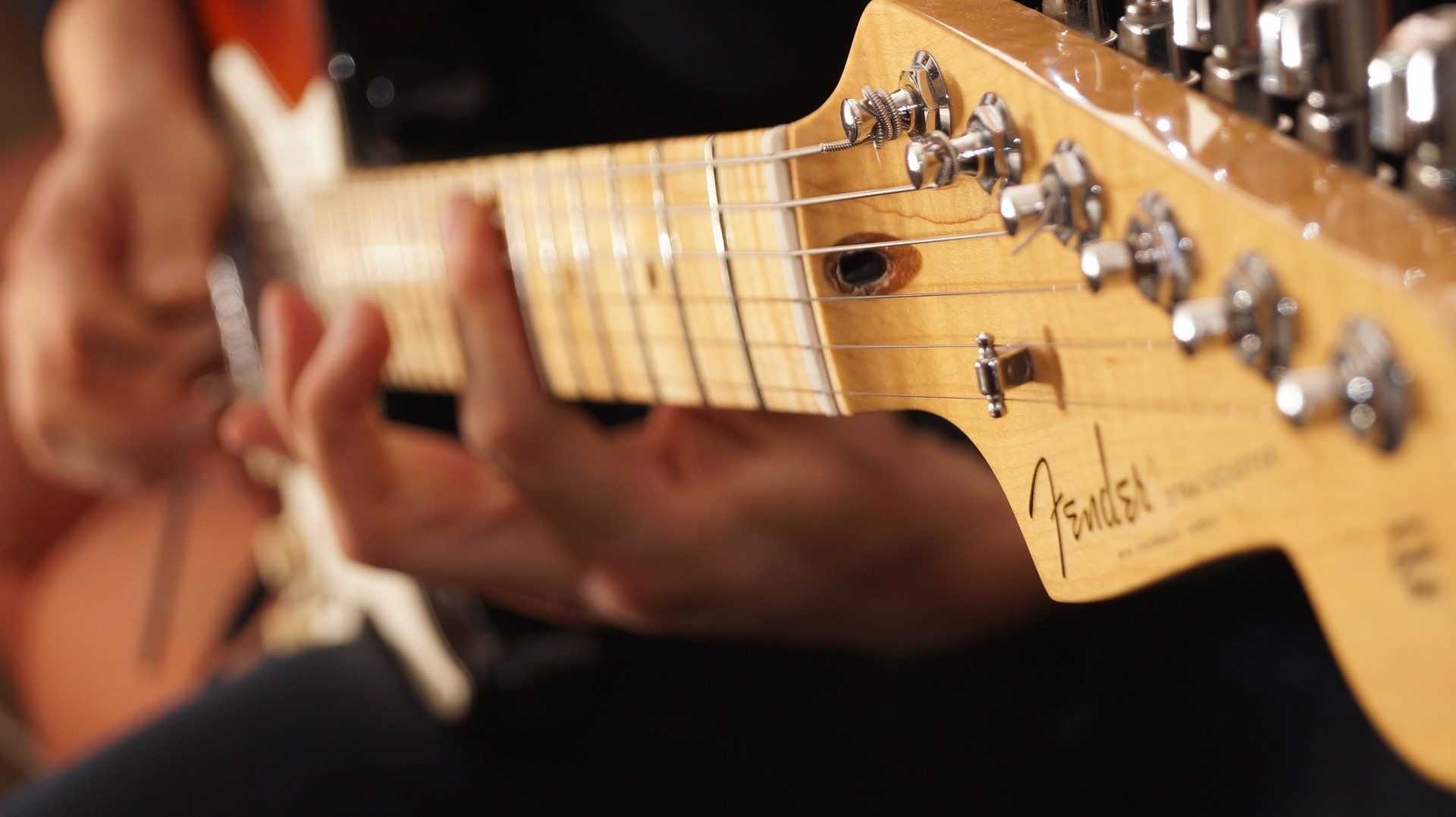
Smashing The Challenge
There's a small problem with this approach, though: progress isn't linear!
As we've already seen, the learning process is full of plateaus and variations.
This means that our calculation probably isn't that accurate.
Let's have another look at that graph:
As we've already seen, the learning process is full of plateaus and variations.
This means that our calculation probably isn't that accurate.
Let's have another look at that graph:

You see, our calculation was based on the first part - where you're getting lots of progress and feeling good.
We have to account for the inevitable plateau, otherwise we won't reach our goals and we'll end up very frustrated!
How do we do this?
It's simple - just double the length of your plan! So, if you calculated 15 hours of practice, do 30 instead.
This takes into account the unpredictable nature of learning, and builds in a safety margin for you. This makes you much more likely to succeed.
In fact, if you wanna be really sure, multiply it by 4 instead! This is a good idea if you're practising shredding, because the faster you are, the longer it takes to improve your speed by the same amount.
We have to account for the inevitable plateau, otherwise we won't reach our goals and we'll end up very frustrated!
How do we do this?
It's simple - just double the length of your plan! So, if you calculated 15 hours of practice, do 30 instead.
This takes into account the unpredictable nature of learning, and builds in a safety margin for you. This makes you much more likely to succeed.
In fact, if you wanna be really sure, multiply it by 4 instead! This is a good idea if you're practising shredding, because the faster you are, the longer it takes to improve your speed by the same amount.
Applying it to Different Skills
But what about measuring other skills, like ear training or scale knowledge?
That's easy too. Let's say you were learning to sing the intervals of the major scale.
For starters, we can imagine that you can't sing any of them. Then, let's say you practice for an hour and manage to learn two out of the seven intervals.
If you learn two per hour, and you know already know two of them, it'll take you 2.5 hours to learn them all.
We can then use the "2x" rule to expand that to 5 hours of practice, or use the "4x" rule to be safe, and plan for 10 hours of practice. This'll really ensure that you know them.
It's that simple!
That's easy too. Let's say you were learning to sing the intervals of the major scale.
For starters, we can imagine that you can't sing any of them. Then, let's say you practice for an hour and manage to learn two out of the seven intervals.
If you learn two per hour, and you know already know two of them, it'll take you 2.5 hours to learn them all.
We can then use the "2x" rule to expand that to 5 hours of practice, or use the "4x" rule to be safe, and plan for 10 hours of practice. This'll really ensure that you know them.
It's that simple!
Process Summary
So here's what you do:
There you have it - the full process in a nutshell.
Once you know how much practice you want to do, you can plan out how much you'll do each day and use the graph to predict how it'll go, and at which points you'll get good progress, encounter difficulties, and conquer the final challenge. Then you'll be prepared for any plateaus, complications, etc. that crop up.
- Set a measurable, specific goal
- Measure your initial ability level (speed, how many scale shapes you know, etc.)
- Practice for a while (at least an hour, preferably two or three)
- Measure how much you've improved, and how much you improve per hour
- Use that to work out how many hours of practice you'll need to reach your goal
- Double (or quadruple) the calculation to account for plateaus and difficulties in learning.
There you have it - the full process in a nutshell.
Once you know how much practice you want to do, you can plan out how much you'll do each day and use the graph to predict how it'll go, and at which points you'll get good progress, encounter difficulties, and conquer the final challenge. Then you'll be prepared for any plateaus, complications, etc. that crop up.
Final Thoughts
Have a go at this, and see how it works for you.
It's fun, it's motivating, and most of all it works - with the right methods you can form a pretty good impression of how fast you'll progress.
Drop me an email and let me know how you get on :)
Have fun, and keep rocking!
Get free guides, updates and lessons by subscribing to the TomGuitar mailing list! It's free, and you can unsubscribe at any time.
It's fun, it's motivating, and most of all it works - with the right methods you can form a pretty good impression of how fast you'll progress.
Drop me an email and let me know how you get on :)
Have fun, and keep rocking!
Get free guides, updates and lessons by subscribing to the TomGuitar mailing list! It's free, and you can unsubscribe at any time.
Share
Tweet
Share
Mail
Copyright Tom Boddison 2022